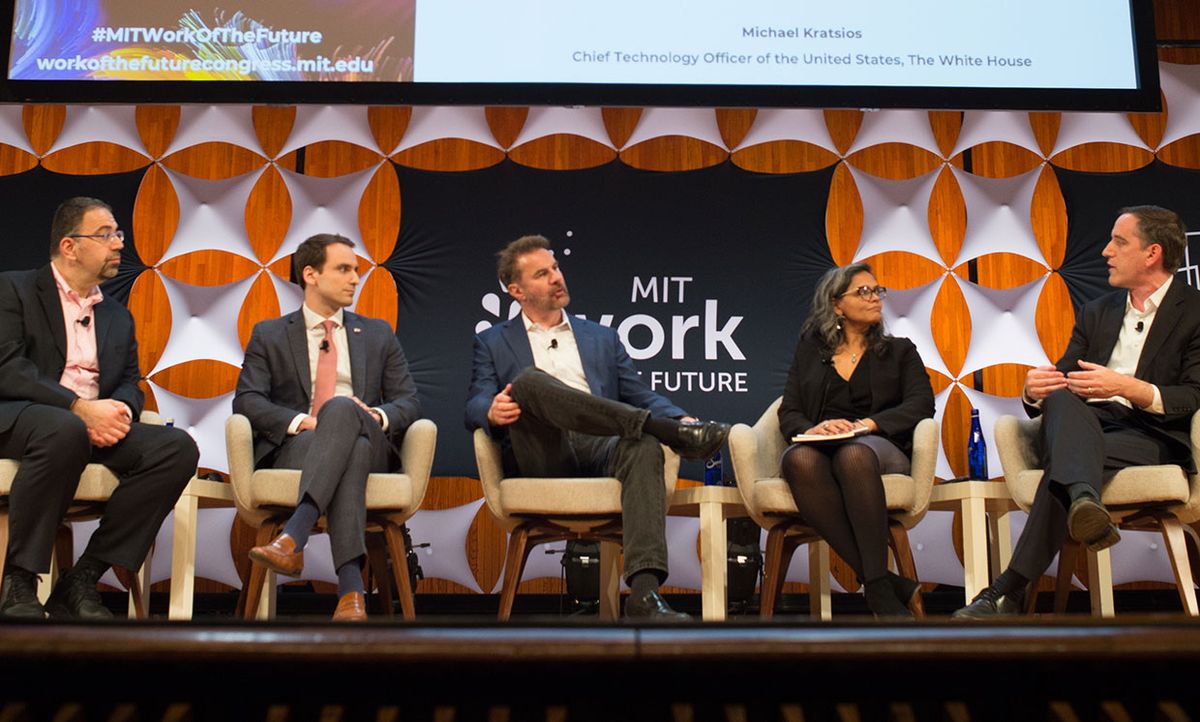This week at MIT, academics and industry officials compared notes, studies, and predictions about AI and the future of work. During the discussions, an insurance company executive shared details about one AI program that rolled out at his firm earlier this year. A chatbot the company introduced, the executive said, now handles 150,000 calls per month.
Later in the day, a panelist—David Fanning, founder of PBS’s Frontline—remarked that this statistic is emblematic of broader fears he saw when reporting a new Frontline documentary about AI. “People are scared,” Fanning said of the public’s AI anxiety.
Fanning was part of a daylong symposium about AI’s economic consequences—good, bad, and otherwise—convened by MIT’s Task Force on the Work of the Future.
“Dig into every industry, and you’ll find AI changing the nature of work,” said Daniela Rus, director of MIT’s Computer Science and Artificial Intelligence Laboratory (CSAIL). She cited recent McKinsey research that found 45 percent of the work people are paid to do today can be automated with currently available technologies. Those activities, McKinsey found, represent some US $2 trillion in wages.
However, the threat of automation—whether by AI or other technologies—isn’t as new as technologists on America’s coasts seem to believe, said panelist Fred Goff, CEO of Jobcase, Inc.
“If you live in Detroit or Toledo, where I come from, technology has been displacing jobs for the last half-century,” Goff said. “I don’t think that most people in this country have the increased anxiety that the coasts do, because they’ve been living this.”
Goff added that the challenge AI poses for the workforce is not, as he put it, “getting coal miners to code.” Rather, he said, as AI automates some jobs, it will also open opportunities for “reskilling” that may have nothing to do with AI or automation. He touted trade schools—teaching skills like welding, plumbing, and electrical work—and certification programs for sales industry software packages like Salesforce.
On the other hand, a documentarian who reported another recent program on AI—Krishna Andavolu, senior correspondent for Vice Media—said “reskilling” may not be an easy answer.
“People in rooms like this … don’t realize that a lot of people don’t want to work that much,” Andavolu said. “They’re not driven by passion for their career, they’re driven by passion for life. We’re telling a lot of these workers that they need to reskill. But to a lot of people that sounds like, ‘I’ve got to work twice as hard for what I have now.’ That sounds scary. We underestimate that at our peril.”
Part of the problem with “reskilling,” Andavolu said, is that some high-growth industries involve caregiving for seniors and in medical facilities—roles which are traditionally considered “feminized” careers. Destigmatizing these jobs, and increasing the pay to match the salaries of displaced jobs like long-haul truck drivers, is another challenge.
Daron Acemoglu, MIT Institute Professor of Economics, faulted the comparably slim funding of academic research into AI.
“There is nothing preordained about the progress of technology,” he said. Computers, the Internet, antibiotics, and sensors all grew out of government and academic research programs. What he called the “blue-sky thinking” of non-corporate AI research can also develop applications that are not purely focused on maximizing profits.
American companies, Acemoglu said, get tax breaks for capital R&D—but not for developing new technologies for their employees. “We turn around and [tell companies], ‘Use your technologies to empower workers,’” he said. “But why should they do that? Hiring workers is expensive in many ways. And we’re subsidizing capital.”
Said Sarita Gupta, director of the Ford Foundation’s Future of Work(ers) Program, “Low and middle income workers have for over 30 years been experiencing stagnant and declining pay, shrinking benefits, and less power on the job. Now technology is brilliant at enabling scale. But the question we sit with is—how do we make sure that we’re not scaling these longstanding problems?”
Andrew McAfee, co-director of MIT’s Initiative on the Digital Economy, said AI may not reduce the number of jobs available in the workplace today. But the quality of those jobs is another story. He cited the Dutch economist Jan Tinbergen who decades ago said that “Inequality is a race between technology and education.”
McAfee said, ultimately, the time to solve the economic problems AI poses for workers in the United States is when the U.S. economy is doing well—like right now.
“We do have the wind at our backs,” said Elisabeth Reynolds, executive director of MIT’s Task Force on the Work of the Future.
“We have some breathing room right now,” McAfee agreed. “Economic growth has been pretty good. Unemployment is pretty low. Interest rates are very, very low. We might not have that war chest in the future.”
Margo Anderson is the news manager at IEEE Spectrum. She has a bachelor’s degree in physics and a master’s degree in astrophysics.



